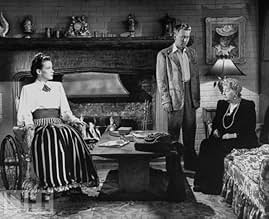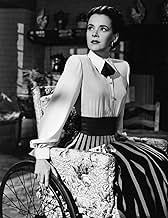Une belle-mère jalouse et manipulatrice confinée dans un fauteuil roulant interfère avec les romances de ses beaux-enfants afin qu'ils ne se marient pas et ne quittent pas la maison.Une belle-mère jalouse et manipulatrice confinée dans un fauteuil roulant interfère avec les romances de ses beaux-enfants afin qu'ils ne se marient pas et ne quittent pas la maison.Une belle-mère jalouse et manipulatrice confinée dans un fauteuil roulant interfère avec les romances de ses beaux-enfants afin qu'ils ne se marient pas et ne quittent pas la maison.
May Whitty
- Clara Brastock
- (as Dame May Whitty)
Jack Deery
- Engagement Party Attendee
- (uncredited)
Gerald Hamer
- Vicar Woolton
- (uncredited)
Doris Lloyd
- Mrs. Woolton
- (uncredited)
Paul Power
- Engagement Party Attendee
- (uncredited)
Gerald Rogers
- Station Master
- (uncredited)
Paul Scardon
- Perowen
- (uncredited)
Margaret Tracy
- Emily
- (uncredited)
Eric Wilton
- Engagement Party Attendee
- (uncredited)
Histoire
Le saviez-vous
- AnecdotesSusan Peters was on a hunting trip on January 1, 1945 when her rifle accidentally discharged and she was shot. This resulted in her being paralyzed from the waist down. This was the only film she made after the accident.
- GaffesToutes les informations contiennent des divulgâcheurs
- Citations
Clara Brastock: Do you really think i'd stay when i'm not wanted?
Mallory St. Aubyn: I think you might.
- Générique farfelu"The return to the screen of Miss SUSAN PETERS"
- Bandes originalesI'll Never Say I Love You (to Anyone but You)
Performed by Susan Peters
Written by Allan Roberts and Lester Lee
Commentaire en vedette
Intense psychological drama of the type so popular at the time. Scheming Leah (Susan Peters) is wheel-chair bound in a houseful of young women; so of course we're all initially sympathetic, but then events begin to unfold. The movie is generally under-rated by the professionals, perhaps because the material sizes up as a "woman's picture". Nonetheless, it's a broodingly atmospheric production, well-acted and superbly directed. Since events take place in and around a single sea-side mansion, keeping the audience engaged becomes a challenge. Thus direction, acting and set design take on more than usual importance. I'm rather surprised that the normally budget-minded and outdoorsy Columbia studio responds as well as it does. Note how beautifully composed each frame is-- director Sturges' very real artistic eye is already in evidence, well before his celebrated conquest of wide-screen Cinemascope. Even the process shots (always a tricky challenge) of a roiling surf are expertly done, adding greatly to the sinister mood. (In passing-- there's a 10 second shot two-thirds of the way through of Phyllis Thaxter standing at a window, exulting in Logan's departure. A brief scene like this could have easily been done in spartan fashion. But notice how artistically this passing shot is both mounted and composed. It's touches like this that add up to a memorable production.) If I'm going on about the technical side, it's because this obscure little film more than most exemplifies studio craftsmanship at its 40's best.
The plot itself provides the tragically star-crossed Peters with her final film role, and she's excellent in a carefully modulated performance that could have easily gone over the top. Notice how expressively she uses her hands and fingers to suggest repressed inner feelings as she navigates through a house full of surging hormones. (I wonder how much of the real person crippled by a hunting accident is in that performance.) On the other hand, Alexander Knox as her husband strikes me as a shade too old and too stolid, but maybe he's supposed to be. The young couple, Logan and Catherine (Diana Douglas) are appropriately callow, while Douglas brings off her big scene with Peters in convincing fashion, a difficult challenge. Too bad that fine actress Phyllis Thaxter is given little more to do than stand around and look helpful as the "other woman". For those whose imagination tends to take over, it's perhaps not a stretch to think of the film as Leah's final few moments before going over the edge. Considering the movie's claustrophobic setting, a strictly "mental" dimension seems not far-fetched. However that may be, the film is a real sleeper, unfortunately under-rated, and well worth a look see, especially on a foggy night.
The plot itself provides the tragically star-crossed Peters with her final film role, and she's excellent in a carefully modulated performance that could have easily gone over the top. Notice how expressively she uses her hands and fingers to suggest repressed inner feelings as she navigates through a house full of surging hormones. (I wonder how much of the real person crippled by a hunting accident is in that performance.) On the other hand, Alexander Knox as her husband strikes me as a shade too old and too stolid, but maybe he's supposed to be. The young couple, Logan and Catherine (Diana Douglas) are appropriately callow, while Douglas brings off her big scene with Peters in convincing fashion, a difficult challenge. Too bad that fine actress Phyllis Thaxter is given little more to do than stand around and look helpful as the "other woman". For those whose imagination tends to take over, it's perhaps not a stretch to think of the film as Leah's final few moments before going over the edge. Considering the movie's claustrophobic setting, a strictly "mental" dimension seems not far-fetched. However that may be, the film is a real sleeper, unfortunately under-rated, and well worth a look see, especially on a foggy night.
- dougdoepke
- 21 sept. 2007
- Lien permanent
Meilleurs choix
Connectez-vous pour évaluer et surveiller les recommandations personnalisées
- How long is The Sign of the Ram?Propulsé par Alexa
Détails
- Date de sortie
- Pays d’origine
- Langues
- Aussi connu sous le nom de
- En kvinna för mycket
- Lieux de tournage
- Lizard Point, Cornwall, Angleterre, Royaume-Uni(rocky coastline shots)
- société de production
- Consultez plus de crédits d'entreprise sur IMDbPro
- Durée1 heure 24 minutes
- Couleur
- Rapport de forme
- 1.37 : 1
Contribuer à cette page
Suggérer une modification ou ajouter du contenu manquant

Lacune principale
By what name was The Sign of the Ram (1948) officially released in India in English?
Répondre




























